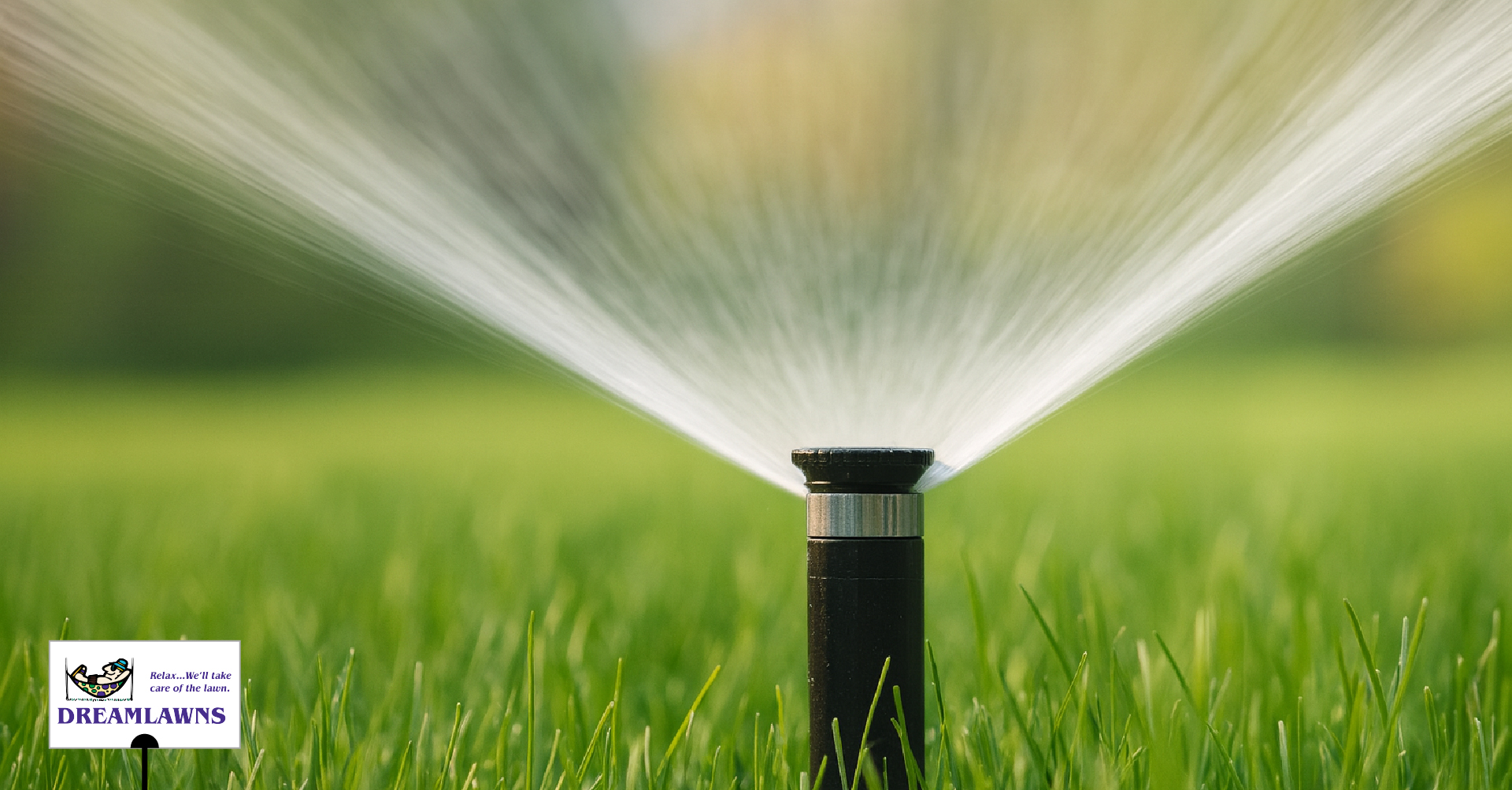
Dreamlawns Quick Cut: As temperatures cool in September, your lawn’s water needs change. Cooler nights, morning dew, and seasonal rainfall slow evaporation, meaning fewer watering cycles are required. But lawns, especially Fescue, still need steady hydration to recover from summer stress and support fall aeration, overseeding, and fertilization. Reduce frequency (not depth), water early in the morning, and balance irrigation with natural moisture.
As summer heat gives way to cooler September mornings in Virginia Beach, your lawn’s water needs begin to change. But many homeowners don’t adjust their watering habits at the right time. Some continue summer’s heavy irrigation schedule, leaving grass overly damp and prone to disease. Others turn systems off too early, assuming cooler weather means the lawn no longer needs water.
Both approaches can leave turf stressed heading into fall, the most important season for recovery, overseeding, and fertilization. September is a transition period where your lawn still needs consistent moisture, but not as much as it did in July or August. Understanding how to balance irrigation with natural rainfall and morning dew is the key to keeping your turf healthy and preparing it for stronger growth.
Let’s explore how to adjust your watering routine for September, why natural sources of moisture matter, and how Dreamlawns can help you set the right schedule for long-term lawn success.
Why Does Your Lawn Need Less Water in September?
September brings cooler nights and shorter days to Virginia Beach, which means your lawn no longer loses moisture as quickly as it did in July and August. Lower temperatures slow evaporation, while higher dew points provide extra surface moisture each morning. On top of that, September often delivers more consistent rainfall, an important form of natural watering that should be factored into your irrigation schedule.
Key reasons your lawn needs less water this month:
- Cooler temperatures slow evaporation and reduce stress on turf.
- Morning dew provides an extra layer of daily moisture.
- More frequent rainfall naturally supplements irrigation.
- Soil retains water longer, meaning fewer watering cycles are needed.
But less water doesn’t mean no water. Your grass is still actively growing in September, especially cool-season varieties like Tall Fescue, even if the pace is slower than in spring. To stay healthy and prepare for fall aeration, overseeding, and fertilization, your lawn still needs steady hydration. The difference is that overwatering now can do more harm than good, creating damp conditions that fuel fungal disease.
How Should You Adjust Your Watering Schedule in September?
As the climate shifts in September, the goal isn’t to stop watering, it’s to water smarter. Lawns still need deep, consistent hydration to recover from summer stress and prepare for aeration, overseeding, and fertilization. The difference is that watering habits from midsummer can easily become too much this time of year.
Best practices for adjusting your schedule:
- Reduce frequency, not depth: Instead of watering 3–4 times per week, scale back to 1–2 deep sessions, providing about 1 inch of water total (including rainfall).
- Water in the early morning: Finish irrigation before 8 a.m. to reduce evaporation and avoid prolonged leaf wetness that can lead to fungus.
- Account for natural rainfall: Skip scheduled watering when the soil is already moist from recent rain. Overlapping irrigation with natural watering is a fast track to oversaturation.
- Test soil moisture before watering: Insert a screwdriver or soil probe. If it pushes in easily and comes out damp, your lawn doesn’t need more water yet.
This transitional approach ensures your turf gets the hydration it needs without encouraging fungal disease or shallow root growth.
How Should You Water Around Aeration and Overseeding?
September is the peak season for aeration and overseeding in Virginia Beach, and watering plays a crucial role in whether these services succeed. Proper moisture helps loosen compacted soil, encourages seed-to-soil contact, and supports strong germination.
Watering tips before and after these services:
- Before aeration: Lightly water your lawn the day before to soften the soil. Moist soil allows aerator tines to pull deeper plugs, creating better channels for air, water, and seed.
- Right after overseeding: Water gently but frequently to keep the topsoil consistently damp. Avoid heavy watering that can cause seed washout, especially on slopes.
- During germination: Continue with light, daily watering until seedlings emerge (about 10–14 days). The goal is to prevent the soil surface from drying out.
- Once established: Transition back to deeper, less frequent watering to encourage seedlings to build deeper root systems.
Balancing irrigation with natural rainfall is especially important at this stage. Too little water slows germination, but too much can suffocate new seedlings or promote disease.
What Are the Most Common Watering Mistakes in September?
September is a transition month, and many homeowners misjudge how much water their lawn actually needs. Overcorrection, whether too much or too little, can create long-term problems for your turf.
The most common mistakes to avoid include:
- Turning irrigation off too early: Cooler weather doesn’t mean your lawn is done growing. Fescue still needs consistent moisture to recover and strengthen roots before winter.
- Overwatering in humid weather: Excess irrigation combined with morning dew can leave grass overly damp, fueling fungal diseases like Brown Patch or Gray Leaf Spot.
- Ignoring natural watering: Rainfall and dew often supply more water than homeowners realize. Failing to account for these sources leads to unnecessary irrigation.
- Treating all lawn zones the same: Shaded areas hold moisture longer, while sunny spots dry faster. Adjusting sprinkler runtimes by zone helps balance coverage.
- Shallow, frequent watering: This encourages weak, shallow roots that are more vulnerable to stress. Deep watering is still important, even in cooler weather.
By avoiding these pitfalls, you’ll keep your lawn properly hydrated while preventing disease, runoff, and wasted water.
How Can Dreamlawns Help You Get It Right?
Watering may seem straightforward, but getting it wrong is one of the biggest reasons homeowners struggle with thin, patchy, or disease-prone lawns. The challenge in September is striking the right balance: your turf still needs consistent hydration to recover from summer stress and support new seed growth, but it’s easy to overdo it when rainfall and morning dew are already adding natural moisture.
That’s where Dreamlawns makes the difference. Our team doesn’t just provide generic advice, we tailor recommendations to your specific property and the unique challenges of Virginia Beach’s coastal climate. Here’s what sets our approach apart:
- Seasonal Assessments for Your Lawn’s Needs: We don’t take a one-size-fits-all approach. Our technicians inspect your lawn’s turf type, density, soil structure, and trouble spots. From there, we recommend the right watering adjustments for your lawn so you’re not wasting water or leaving your lawn vulnerable.
- Integration with Aeration, Overseeding, and Fertilization: Fall services only succeed if the soil stays consistently moist. Aeration requires pre-moistening to allow deeper plugs, while overseeding depends on light, frequent watering during germination. Fertilizer also works best when watered into the soil. We help you coordinate irrigation around these services to maximize results.
- Year-Round Lawn Care Programs: For homeowners who want peace of mind, Dreamlawns offers full-service programs that adapt seasonally. That means your lawn receives expert attention in spring, summer, fall, and winter, with watering recommendations built into each step. From summer drought stress to fall recovery, you’ll always know your lawn is on track.
- Local Expertise in a Unique Climate: Virginia Beach’s sandy soils drain faster than clay-heavy soils in other regions, and our coastal humidity adds extra fungal pressure. These local factors matter, and our team has decades of experience tailoring care to the Tidewater area’s unique conditions.
With Dreamlawns, you’re not left guessing about when or how much to water. You get professional guidance, proven strategies, and services that ensure your lawn not only survives the transition from summer to fall, but thrives.
Keep Your Lawn Hydrated, Not Soaked, This September
September is all about balance. Your lawn no longer needs the heavy irrigation of midsummer, but shutting off the sprinklers completely is just as damaging. By adjusting your watering habits to match cooler temperatures, morning dew, and natural rainfall, you give your turf the steady moisture it needs to recover from summer stress and prepare for aeration, overseeding, and fertilization.
At Dreamlawns, we make these transitions simple. Our team understands the unique conditions of Virginia Beach lawns and offers both seasonal services and year-round programs designed to keep turf healthy in every season. With the right watering plan and the right partner, you can enjoy a thicker, greener, and more resilient lawn heading into fall and beyond.
Contact us today to schedule your fall services and make sure your lawn is set up for success this season.
Dreamlawns provides superior lawn care service to Virginia Beach & Chesapeake VA residents.




